The Retailer's Guide to Facebook Video Ads
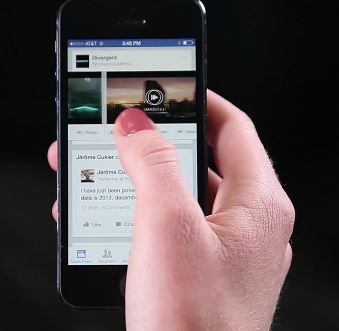

People now watch over 100 million hours of Facebook video ads on the social platform each day. The digital video advertising market is growing rapidly at 43.5% year over year and by 2017, eMarketer projects that digital video advertising will make up 15% of the total digital advertising market.
Facebook values video and knows their audience does too. Shoppers who view video are 1.81 times more likely to purchase than non-viewers and more than half of the marketing professionals worldwide name video as the type of content with the best ROI.
Because advertisers cite a 40 percent increase in purchases as a result of video – specifically in the categories of apparel, home goods, and electronics – retailers & brands should be investing in their Facebook video efforts more now than ever before.
 Unfortunately, many companies still don’t use video ads. According AdEspresso, these businesses (especially the smaller ones) are “held back by the notion that video is too hard to make, or doesn’t produce conversions the way other ads do.”
Unfortunately, many companies still don’t use video ads. According AdEspresso, these businesses (especially the smaller ones) are “held back by the notion that video is too hard to make, or doesn’t produce conversions the way other ads do.”
But that is where they are wrong. If retailers (especially for certain categories) are not using video in their social outreach campaigns, it’s likely they are missing out on an opportunity to build brand awareness and increase conversions.
What sets Facebook apart from it’s competitors is it’s unique ability to harvest vast amounts of customer information to create custom audiences, generate warm leads and build reputable branding – all within a platform that is already known for it’s engagement opportunity.
In addition, Facebook rewards advertisers for shares with cheaper views, cheaper clicks, and more impressions. This combination leads to an overall better ROI.
In the following blog post, we will discuss Facebook Video Ads, with expert insight on:
Facebook video ads are located in the Mobile News Feed, Instagram, Audience Network, Desktop News Feed, and Desktop Right Column.

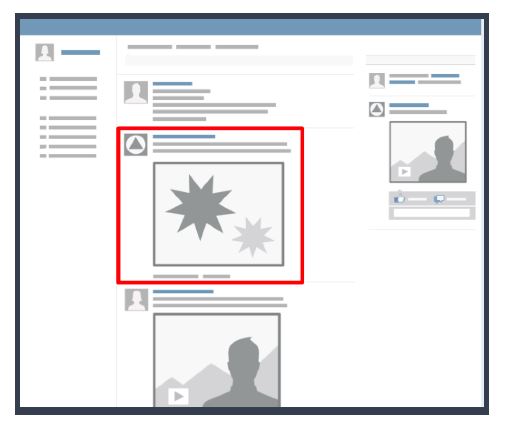

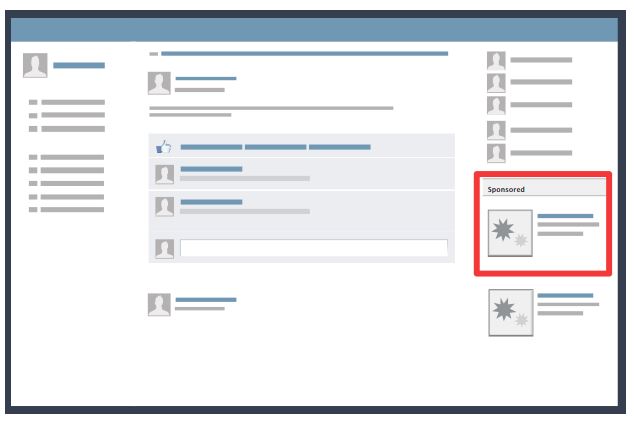
Pro-Tip: Recently, Facebook rolled out a new advertising placement for video ads. If you’ve ever clicked on a video ad in your news feed – you’ve probably noticed a black box that pops up – prompting you to scroll through other similar videos below. Approximately every third video in this placement is now a Sponsored Ad.
To create a Facebook video ad:
From here, you can set your targeting, budget and schedule. Additionally, advertisers can select interests, behaviors, location, age and gender of the audience they want to reach.
Retailers can upload a new video or use one from their library and select a thumbnail image. The final step is to add text, and create a clear and simple message that encourages your audience to view your video.
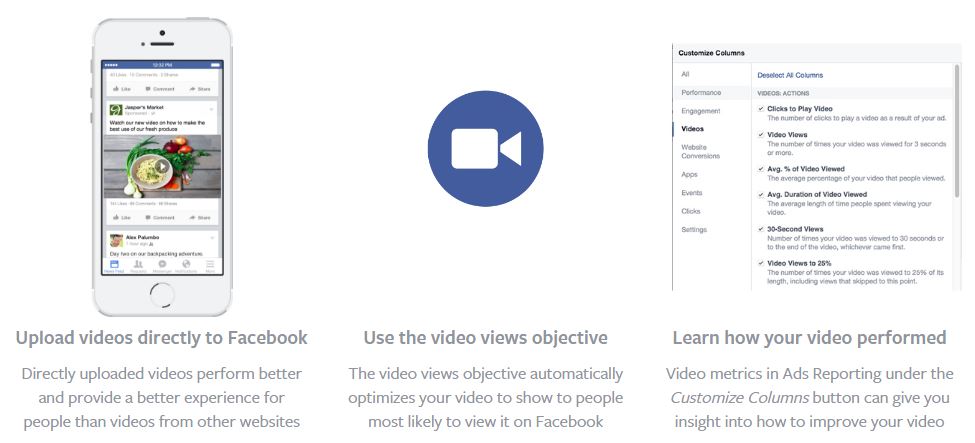
Pro-Tip: Facebook video ads are typically on mute, but Facebook will add captions (as we explain below in the section on the new Automated Captions feature) if selected by the advertiser.
Facebook Slideshow Ads – Slideshow ads allow advertisers to quickly create and edit video ads that are lightweight and optimized for a mobile world. By stitching photos together and adding text and sound, slideshow lets retailers create, boost, and edit videos. You can upload your own photos, use your Page’s photos, or use stock images to create slideshows. Slideshows use less data and load faster than the average video ad, making them ideal for users on low bandwidth connections.

Facebook Video Carousel Ads – Pairing video with the carousel format gives marketers more options for creating compelling storytelling in News Feed. Videos can be used in any slot of the carousel unit. Video in the Carousel format is currently available in Power Editor. Videos can be used in any slot of the carousel unit and up to 10 videos and/or images can be uploaded, however only 5 cards will appear at a time. Click here for more examples.
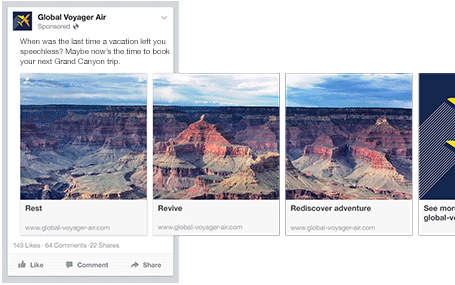
Instagram Video Ads – Video ads offer the same visually immersive quality as photo ads on Instagram — with the power of sight, sound and motion. Retailers can share videos up to 60 seconds long and in landscape format.
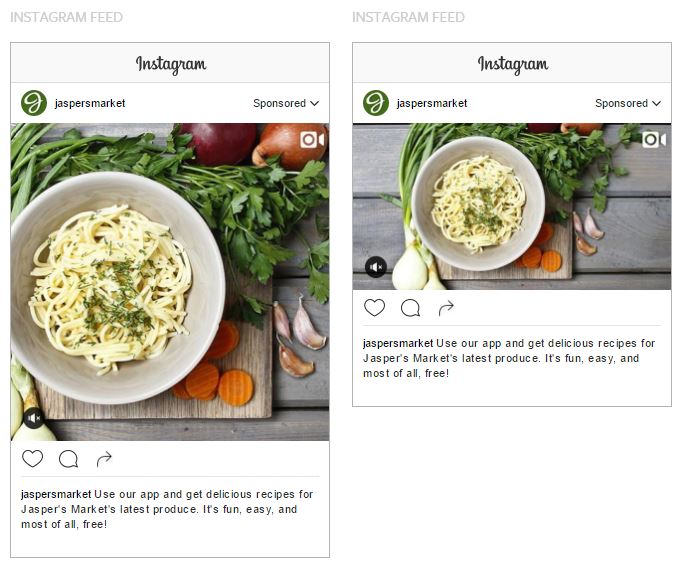
Instagram Video Carousel Ads – In May, Instagram also announced that it was releasing video to carousel ads for all advertisers. Carousel ads on Instagram contain up to five components of photo and videos (each video maximum of 60 seconds). Instagram video carousel ads can run across Instagram and Facebook, and they can also be created in Facebook’s Ads Manager or Power Editor.
Facebook Canvas – You can easily build your Canvas using a combination of videos, still images and call-to-action buttons. In Canvas, people can swipe through a carousel of images, tilt to view panoramic images and zoom in to view images in detail. Canvas was built to bring content to life in a fast-loading and seamless experience on Android and iOS. Leveraging the same technology used to display photos and videos quickly in the Facebook app, Canvas loads quickly, as much as 10 times faster than the standard mobile web.
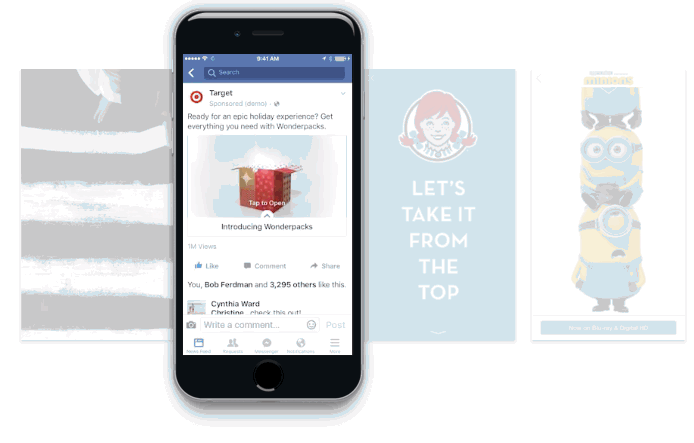
 Campaign objectives for Facebook Ads typically fall into one of two categories—brand awareness or direct response (DR).
Campaign objectives for Facebook Ads typically fall into one of two categories—brand awareness or direct response (DR).
In the past, Facebook only focused on improving their capabilities for items that fell under the DR objective, like online conversion or app installs. But within the past year, Facebook has shifted focus to feature more options aimed at improving brand awareness for video.
“When you set up a video campaign, you must select your campaign objective. As an advertiser, you have to think – What do I want to come from this video? Is the most important objective to get in front of as many people as possible or is to drive revenue and push people to your site?” – Sarah Rogers, Senior Social Strategist at CPC Strategy said.
Get video views – A “video view” is defined as a view of three seconds or more and will appear for all videos. Facebook has also renamed the “video plays” metric to “clicks to play video.” Facebook automatically optimizes these ads to be shown to the people most likely to view videos on Facebook, across devices and across target audiences.
Video views is the main objective optimized to “drive video views” – however, advertisers can use video in other campaign objectives including:
Boost your posts – Boosted posts appear higher in News Feed and on Instagram, so there’s a better chance your audience will see them. You can boost most posts you create on your Page, including status updates, photos, videos and offers.
“For example, a retailer can organically post a video and then boost it with spend. They can also use video in replacement of an image on a website card or a carousel unit,” Rogers said.
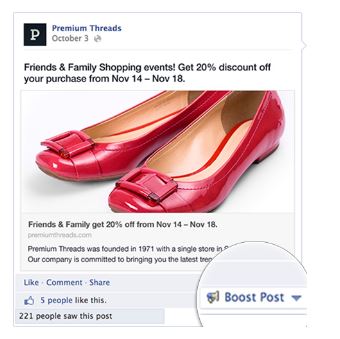
Promote your Page – Promoting your Page is a way to create ads that will show in News Feed, on the right side of Facebook and on Instagram.
Clicks to Website – You can send people to any section of your website from your Facebook ad. When people click or tap your ad, they can go to your home page, online store, product page or any page you choose. Select Clicks to Website and enter the web page address you want people to visit. Choose your home page, a product page or even your online store—you decide where your customers arrive when they click or tap your Facebook ad.
Increase Website Conversions – The website conversions advertising objective allows retailers to create a pixel to place on their website. The pixel can track conversions such as checkouts, registrations, leads, key page views, or customers adding items to a cart. The benefit of this advertising objective is that it helps advertisers measure how many conversions different versions of their ads are generating, and improve their ads to get more website conversions. Retailers can also optimize their ad delivery and ad spend for conversions, by combining a conversion pixel with the bidding option.
Collect leads for your business – Lead ads help businesses to collect potential customers through the process of signing up for events, offers, newsletters or other information. Video lead ads are similar to the way photos work. For example, when someone clicks on the call-to-action button below the video they are directed to the lead ad form.
Other objectives that allow the integration of video also include Increase ticket sales, Get installs of your app. Click here for more on Facebook advertising objectives.
“The cost of the video is dependent on the objective. For example, if the objective is to send people to your website – you are paying for clicks to site,” Rogers said.
“If you are using a video views objective – it’s typically less expensive and you can choose a variety of different ways to optimize for it. The standard is that you would get charged after a 3 second view but you can also choose to pay for a 10 second click, select auto or select your own bid. I usually select auto.”
“Video is typically the cheapest of all the ad types on Facebook. The majority of the reason for that is because Facebook is geared heavily towards video and is trying to encourage advertisers to use it as much as possible,” Rogers said.
 “Because of this, they are willing to eat the cost a little bit. Typically, video ads result in much lower CPMs, and have the potential to reach a lot more people for the same price as a static ad.”
“Because of this, they are willing to eat the cost a little bit. Typically, video ads result in much lower CPMs, and have the potential to reach a lot more people for the same price as a static ad.”
“For retailers that have a small budget – video is the best way to introduce people to your brand and get in front of a larger audience for a lower cost than other types of campaigns.”
So, how does Facebook Video ad cost compare to YouTube?
In YouTube advertising, the advertiser is charged per view. The YouTube view is only counted after 30 seconds or the full duration of the video (if it’s shorter than the 30 second mark).
In contrast, Facebook, charges by cost per 1,000 impressions (CPM) and a “view” is counted after only 3 seconds. Facebook also displays the Cost Per View by dividing the total spend of the campaign by the views.
Facebook provides metrics on video views, unique video views, the average duration of the video view and audience retention. These metrics are designed to help advertisers learn what’s resonating with people and determine how to more effectively create and promote videos on Facebook.
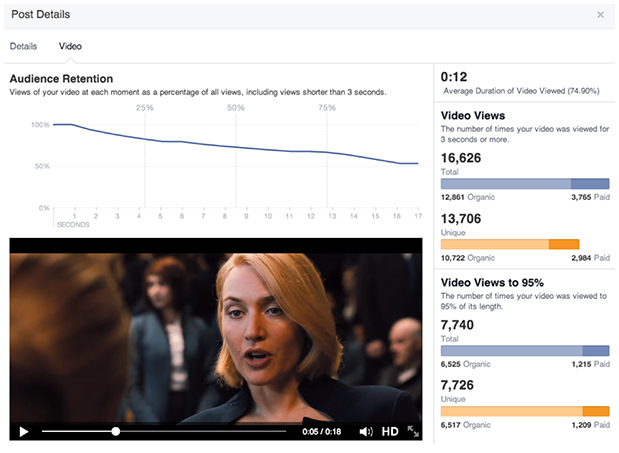
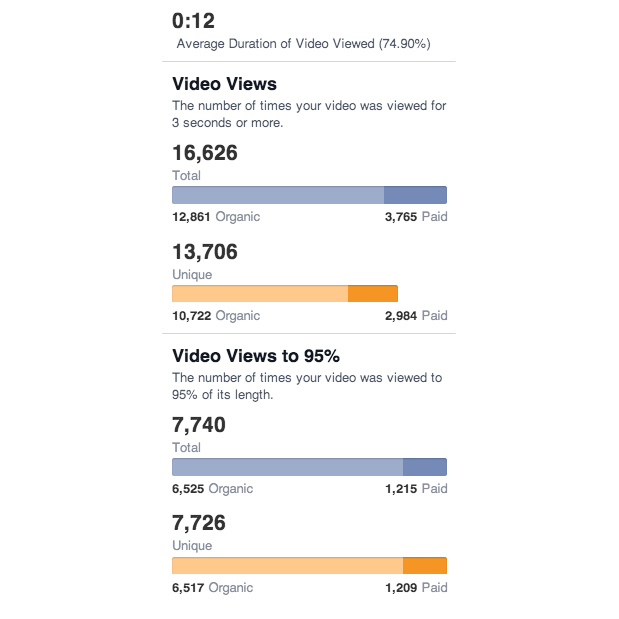
So, which video metrics should Facebook advertisers focus on?
“In Facebook you can view who watched your video up to 25%, 50%, 75% and all the way through the entire duration of the video. So, I would look at the Cost Per View for each of those percentages,” Rogers said.
“Also look at the View Rate for each of those and where that drop off is. This metric usually gives a pretty good indication if people are engaged for the first 3 seconds. If they drop off rapidly after that 3 second mark – that could also be an indicator that your video wasn’t super compelling.”
“In terms of video length, shorter is sweeter in social. I would recommend under 2 minutes, but 30 seconds to 1 minute is the sweet spot, although recently a lot of advertisers are pushing the idea of telling a story with a longer video.”
Video is a unique ad type because it allows advertisers to capture everyone who has viewed their video (or part of their video) and create new audiences to target based on that information.
Facebook retargeting is known as the lowest hanging fruit for advertisers because it allows retailers to show their ads to shoppers who have already visiting their website or clicked on one of their products.
Facebook retargeting is one of the most powerful forms of online display advertising because advertisers can target people who have already expressed active interest in their product or site.
If retailers can catch their customers at the right point in the shopping journey and keep their products / brand top of mind, there is very good chance they will profit.
 According to Stephen Kerner, Retail Search Manager and Facebook expert at CPC Strategy, approximately 98% of retailers will have to engage in paid advertising efforts (like Facebook retargeting) if they want to see results in 2016.
According to Stephen Kerner, Retail Search Manager and Facebook expert at CPC Strategy, approximately 98% of retailers will have to engage in paid advertising efforts (like Facebook retargeting) if they want to see results in 2016.
To learn more, check out our interview with Kerner in “The 2016 Guide to Facebook Retargeting“
The available Facebook targeting capabilities for video include:
Recent Purchases: Facebook allows you to take advantage of past purchase behaviors to target people broadly, i.e. Clothing, Food & Drink, Health & Beauty, to more specific subcategories, i.e. Fashionistas, DIYers and Foodies.
Custom Audiences: Advertisers can upload existing contacts onto the Facebook platform to create audiences and get in front of customers in a new way; this is a great opportunity to nurture leads and build loyalty with existing customers.
Lookalike Audiences: After establishing a custom audience, Facebook can help you generate new audiences that have similar interests to the existing contacts. If you do not have contacts to create a custom audience, you can use your Facebook fan base or tracking pixels to create custom audiences to imitate.
Layered Targeting: Because Facebook has such a stock of information on its user base, it is able to offer many options to target the perfect audience, i.e. Household Composition, Net Worth, Interests, Behaviors, etc. Using these together, you can generate a highly specific segment to which you can serve ads.
Life Events: The Life Events parameter in Facebook Advertising is unique to the platform, allowing you to target people at specific intervals of time after the event takes place; i.e. a year after getting married, 3 months after starting a new job, etc.
According to Facebook, the faster you communicate your message in a video ad and capture viewers’ attention, the better.
Fors-Marsh tests revealed that shoppers can recall mobile News Feed content after seeing it for only a quarter of a second. This means that the value of a product’s video ad—whether you’re measuring ad recall, brand awareness, or sales—happens quickly and increases with duration.
That is why in February 2016, Facebook introduced a new video feature to help advertisers connect with their audience and build brand awareness more effectively: Automated Captioning
Unfortunately, when video was first introduced to Facebook’s audience, they were forced to deal with a number of marketing sensitivity issues including video sounds and images. Studies have found that in mobile-feed environments, people prefer having the choice to opt in to sound.
Facebook also tested this theory and discovered that when feed-based mobile video ads play loudly when people aren’t expecting it, 80% react negatively, both toward the platform and the advertiser.
Think about it: Who wants to blast a video ad in the middle of a quiet bus ride or at the office? Nobody.
Advertisers quickly realized they would need to communicate to their audience in a format that did not require sound. This lead to a flood of “worksafe” videos – made popular by media organization such as Business Insider or Buzzfeed.
Facebook’s testing found that captioned video ads increased video time by an average of 12%, which lead to the introduction of a new tool that allows advertisers to add in captions to their video.
Pro-Tip: To clarify, “worksafe” videos refer to the use of titles (rather than captions), while Facebook’s new tool feature specifically focuses on the addition of captions only. Essentially, the two format’s accomplish the same thing – a video conveying a message without the use of sound.
Previously, advertisers were only able to add captions to Facebook video ads by embedding captions or uploading their own caption files. But now, advertisers can choose to have captions added automatically. The new automated captioning tool generates captions for video ads and delivers them to the advertiser within the ad creation tool to review, edit and save to their video ad.
When you add captions to your video ads, remember that these captions are added to the video itself, not the ad. If you use the same video in multiple ads, the captions you add to the video will appear in every ad that uses that video. If you’ve used the video with captions in multiple ads and change it in one, it will be changed in all other ads that use the video.
Pro-Tip: Automated captions are available through Power Editor and may be added to most video ads. Currently, automated captions are only available for the English language. Automated captions are not yet available for video carousel ads, video ads on Instagram, 360 videos or Canvas.
Value the Three Second Audition: Advertisers should pack their most valuable and engaging content within the first 3-5 seconds of their video. The video creative should immediately grab the readers attention and demonstrate the value of the brand using engaging subtitles and visuals. For example, if you feature a well known influencer – they should be introduced at the very beginning of the video clip
Don’t rely on Audio: It’s not that audio doesn’t matter but because you only have 3 seconds to get a Facebook user’s attention- you should not rely on music to spark their interest. Most Facebook ads are restricted to autoplay. Best way to test this is to ask yourself – does my video make sense without audio? For example – a one on one interview without subtitles with an unknown person is likely to lack the luster preferred by Facebook users today.
Educate your audience: Facebook users prefer to digest information quickly. Try to break down your content into quick tips that establish your brand or product as an essential. We recommend videos are no longer than 2 minutes. Although the “storytelling” trend is growing in popularity – if you’re just starting out, you’re better off keeping it short and sweet focusing on that 3-5 second mark.
Leverage reviews: Potential customers value reviews from previous buyers. We’ve seen this across a variety of shopping platforms and Facebook is no different. In addition to reviews – leverage user generated content. This will feel less invasive than traditional marketing – and is likely to resonate with your target audience.
For more on Facebook Video Ads, email [email protected]
How to Create the Best Facebook Ads
The 2016 Guide to Facebook Retargeting
Facebook Product Ads: What the New Program Means for Retailers
Facebook Dynamic Product Ads Live in Power Editor
Facebook Friend-To-Friend Payments Paves the Way for Ecommerce Platform
Facebook on the Forefront of Retail Advertising with TheFind Buyout
Q&A with Brian Carter Bestselling Author of ‘Facebook Marketing’
5 Retail Experts Weigh in on Facebook Product Ads
How to Get a Higher ROI on Facebook Ads Using AdEspresso
